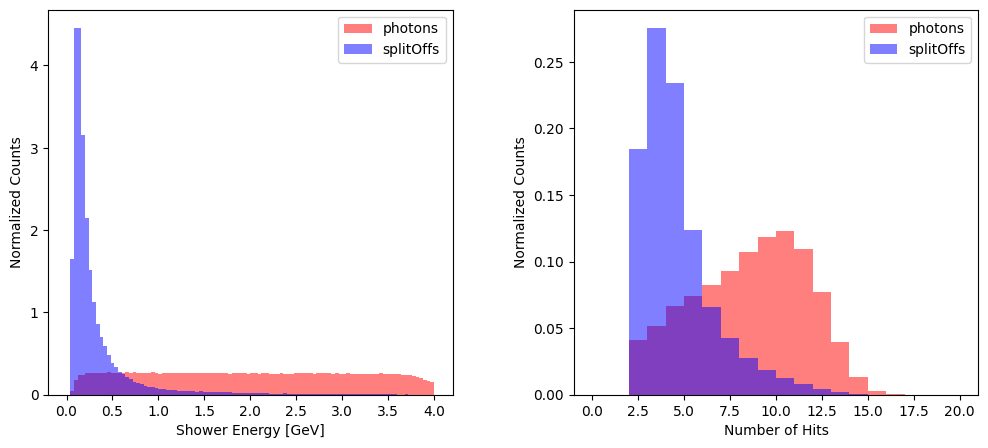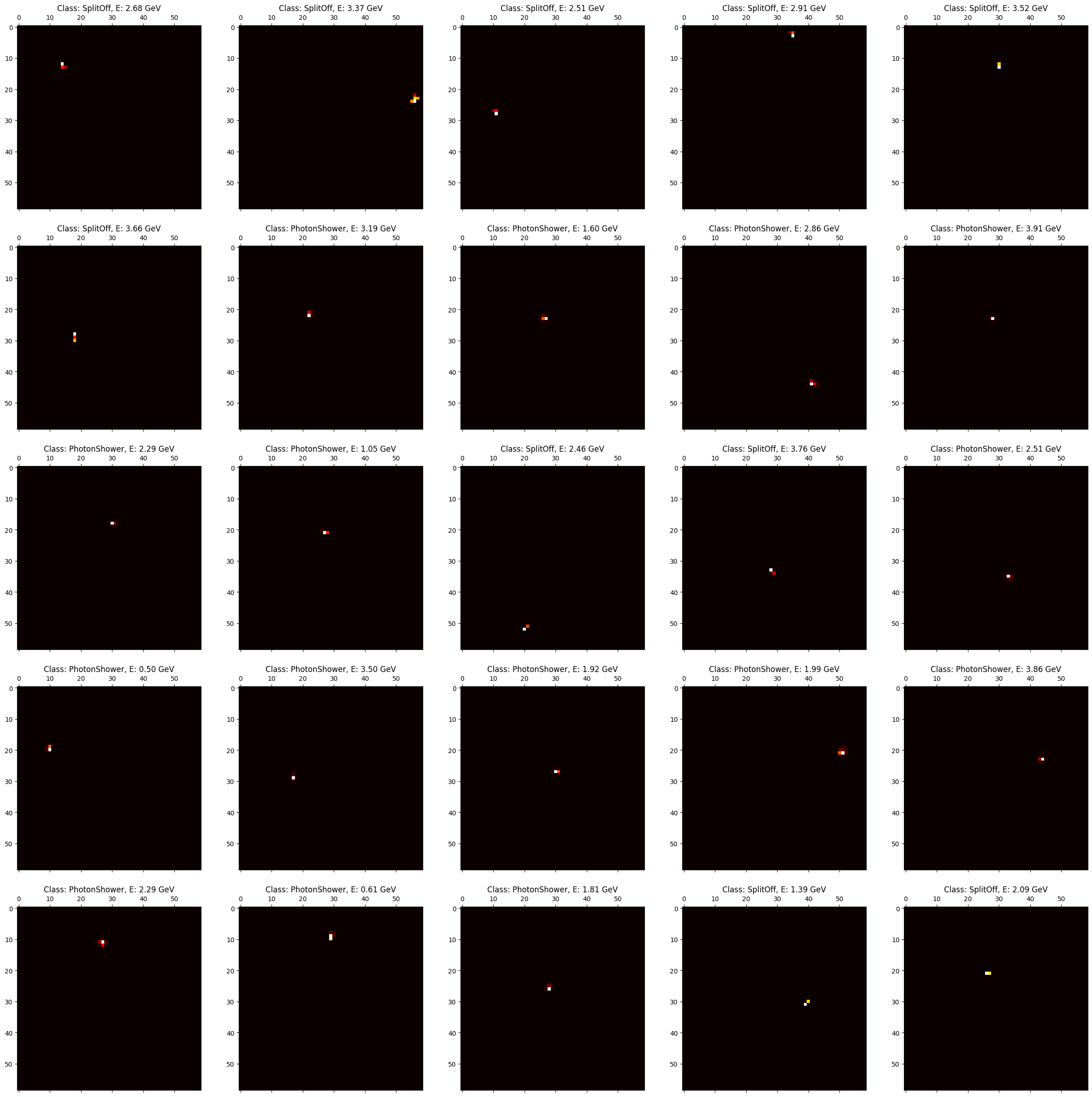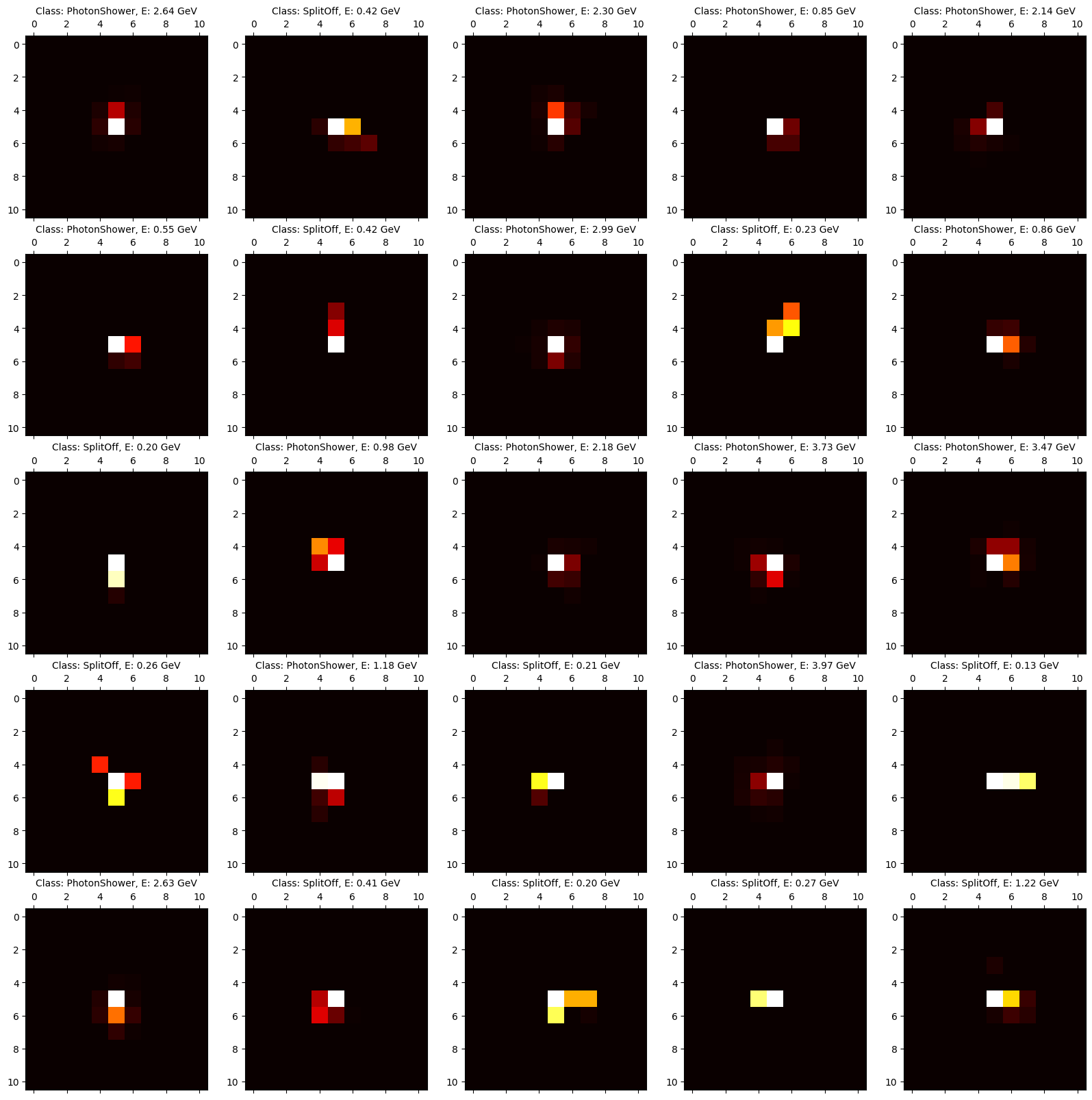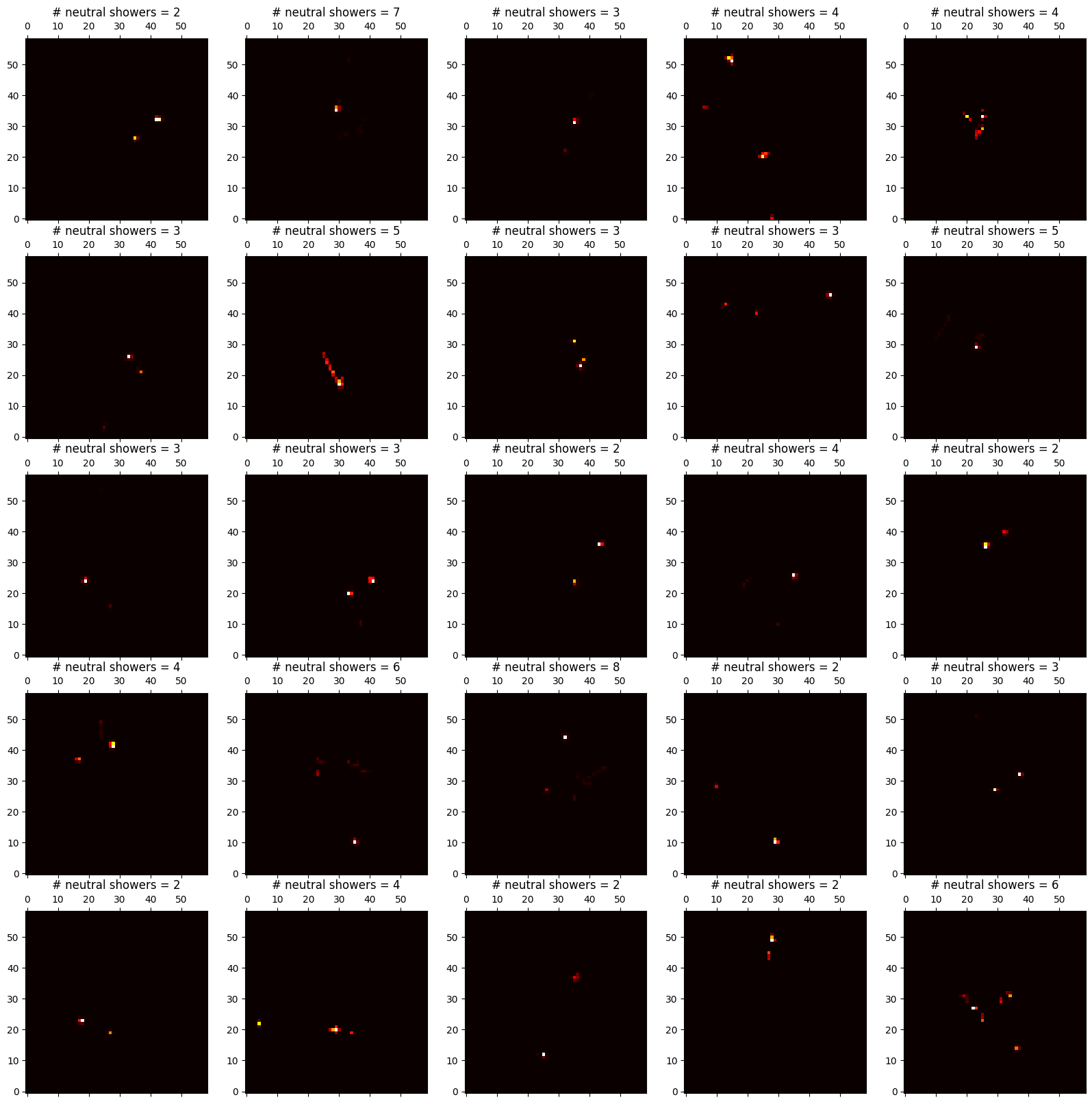Data Preprocessing#
Particle Gun#
The dataset is found in hugging face dataset
particle name |
momentum range [GeV] |
theta (\(\theta\)) range [deg] |
phi (\(\phi\)) range [deg] |
No Of Events |
|---|---|---|---|---|
\(\gamma\) |
0.1 - 4.0 |
1 - 11 |
0 - 360 |
500k |
\(\pi^{+}\) |
0.1 - 4.0 |
1 - 11 |
0 - 360 |
250k |
\(\pi^{-}\) |
0.1 - 4.0 |
1 - 10 |
0 - 360 |
250k |
FCALShowers tree#
The FCALShowers tree stores reconstructed and truth-level information for individual showers in the Forward Calorimeter (FCAL).
Each entry corresponds to one shower and includes both thrown particle kinematics (from Monte Carlo truth) and reconstructed shower quantities derived from detector hits.
Variable Name |
Type |
Shape / Count |
Description |
|---|---|---|---|
|
|
Scalar |
Particle ID (PDG code) of the thrown particle generating this shower. |
|
|
Scalar |
True (thrown) particle energy in GeV. |
|
|
Scalar |
X-coordinate of the thrown particle’s production vertex (cm). |
|
|
Scalar |
Y-coordinate of the thrown particle’s production vertex (cm). |
|
|
Scalar |
Z-coordinate of the thrown particle’s production vertex (cm). |
|
|
Scalar |
X-component of the thrown particle momentum (GeV/c). |
|
|
Scalar |
Y-component of the thrown particle momentum (GeV/c). |
|
|
Scalar |
Z-component of the thrown particle momentum (GeV/c). |
|
|
Scalar |
True mass of the thrown particle (GeV/c²). |
|
|
Scalar |
Number of FCAL blocks (crystals) contributing to this shower. |
|
|
Scalar |
Flag indicating whether the shower lies close to the calorimeter edge (can affect reconstruction). |
|
|
Scalar |
Total reconstructed energy of the shower (GeV). |
|
|
Scalar |
X-position of the reconstructed shower centroid (cm). |
|
|
Scalar |
Y-position of the reconstructed shower centroid (cm). |
|
|
Scalar |
Z-position of the reconstructed shower centroid (cm). |
|
|
Scalar |
Number of hit entries in the |
|
|
Variable-length |
Row indices of FCAL cells contributing to the shower. |
|
|
Scalar |
Number of hit entries in the |
|
|
Variable-length |
Column indices of FCAL cells contributing to the shower. |
|
|
Scalar |
Number of energy values in the |
|
|
Variable-length |
Energy deposited in each hit cell (GeV). |
|
|
Scalar |
Flag indicating if this shower is identified as a split-off from a nearby hadronic interaction. |
|
|
Scalar |
True if the shower is a ‘good’ photon shower. |
Notes:#
Arrays (
rows,cols,energies) contain per-hit information for the FCAL blocks belonging to that shower.Energy ratios (
E1E9) – The central crystal to surrounding 3×3 block (used to identify EM vs hadronic showers).Energy ratio (
E9E25) – The 3×3 vs 5×5 crystal windows around the shower maximum (shower compactness measure)The boolean flags (
isSplitOff,isPhotonShower) are used to build labeled datasets for classification tasks such as photon identification.thrown*quantities provide the Monte Carlo truth-level reference for evaluating reconstruction performance and training regression models.
%pip install uproot awkward-pandas pandas matplotlib seaborn vector tqdm plotly > /dev/null
Note: you may need to restart the kernel to use updated packages.
import os
from urllib.parse import urlparse
import urllib.request
from tqdm import tqdm
class DownloadProgressBar(tqdm):
"""Custom TQDM progress bar for urllib downloads."""
def update_to(self, blocks=1, block_size=1, total_size=None):
"""
Update the progress bar.
Args:
blocks (int): Number of blocks transferred so far.
block_size (int): Size of each block (in bytes).
total_size (int, optional): Total size of the file (in bytes).
"""
if total_size is not None:
self.total = total_size
self.update(blocks * block_size - self.n)
def download(url, target_dir):
"""
Download a file from a URL into the target directory with progress display.
Args:
url (str): Direct URL to the file.
target_dir (str): Directory to save the file.
Returns:
str: Path to the downloaded (or existing) file.
"""
# Ensure the target directory exists
os.makedirs(target_dir, exist_ok=True)
# Infer the filename from the URL
filename = os.path.basename(urlparse(url).path)
local_path = os.path.join(target_dir, filename)
# If file already exists, skip download
if os.path.exists(local_path):
print(f"✅ File already exists: {local_path}")
return local_path
# Download with progress bar
print(f"⬇️ Downloading {filename} from {url}")
with DownloadProgressBar(unit='B', unit_scale=True, miniters=1, desc=filename) as t:
urllib.request.urlretrieve(url, filename=local_path, reporthook=t.update_to)
print(f"✅ Download complete: {local_path}")
return local_path
data_dir = "data"
unformatted_particle_data_url = "https://huggingface.co/datasets/AI4EIC/DNP2025-tutorial/resolve/main/unformatted_dataset/ParticleGunDataSet_800k.root"
dataset_path = download(unformatted_particle_data_url, data_dir)
⬇️ Downloading ParticleGunDataSet_800k.root from https://huggingface.co/datasets/AI4EIC/DNP2025-tutorial/resolve/main/unformatted_dataset/ParticleGunDataSet_800k.root
ParticleGunDataSet_800k.root: 102MB [00:01, 95.2MB/s]
✅ Download complete: data/ParticleGunDataSet_800k.root
# Lets look into the ALLFCALHits tree of the files,
import uproot, pandas as pd, matplotlib.pyplot as plt
import numpy as np
dataset_tree = uproot.open(dataset_path)["FCALShowers"]
for branch in dataset_tree.branches:
print (f"{branch.name} of type {branch.typename}")
index of type int64_t
thrownPID of type int32_t
thrownEnergy of type double
thrownPosition_fX of type double
thrownPosition_fY of type double
thrownPosition_fZ of type double
thrownMomentum_fX of type double
thrownMomentum_fY of type double
thrownMomentum_fZ of type double
thrownMass of type double
numBlocks of type int32_t
isNearBorder of type bool
showerE of type double
showerPos_fX of type double
showerPos_fY of type double
showerPos_fZ of type double
nrows of type int32_t
rows of type int64_t[]
ncols of type int32_t
cols of type int64_t[]
nenergies of type int32_t
energies of type double[]
isSplitOff of type bool
isPhotonShower of type bool
df = dataset_tree.arrays(library="pd")
print (f"DataFrame shape: {df.shape}")
DataFrame shape: (814151, 24)
## Lets look into some of the distributions
photon_df = df[df['isPhotonShower'] == 1]
splitOffs_df = df[df['isSplitOff'] == 1]
print (f"Number of photon showers: {photon_df.shape[0]}")
print (f"Number of split-off showers: {splitOffs_df.shape[0]}")
fig, axs = plt.subplots(nrows = 1, ncols = 2, figsize = (12, 5), gridspec_kw={"hspace": 0.45, "wspace": 0.30})
ax = axs[0]
ax.hist(photon_df["showerE"], bins = 100, range = (0., 4.0), label = "photons", alpha = 0.5, density = True, color = "red")
ax.hist(splitOffs_df["showerE"], bins = 100, range = (0., 4.0), label = "splitOffs", alpha = 0.5, density = True, color = "blue")
ax.set_xlabel("Shower Energy [GeV]")
ax.set_ylabel("Normalized Counts")
ax.legend()
ax = axs[1]
ax.hist(photon_df["nrows"], bins = 20, range = (0, 20), label = "photons", alpha = 0.5, density = True, color = "red")
ax.hist(splitOffs_df["nrows"], bins = 20, range = (0, 20), label = "splitOffs", alpha = 0.5, density = True, color = "blue")
ax.set_xlabel("Number of Hits")
ax.set_ylabel("Normalized Counts")
ax.legend()
plt.show()
Number of photon showers: 434845
Number of split-off showers: 379306

# Lets make a HitMap of all the hits.
FCAL_GEOMETRY = (59, 59)
def MakeHitMap(evnt, min_hits = 1):
if len(evnt.rows) < min_hits: return None
matrix_energies = np.zeros(FCAL_GEOMETRY)
matrix_energies[evnt.rows, evnt.cols] = evnt.energies
return matrix_energies
# Lets draw a few images side by side
titles = ["isPhotonShower", "isSplitOff"]
NROWS = 5
NCOLS = 5
fig, axs = plt.subplots(nrows = NROWS, ncols = NCOLS, figsize = (30, 30))
for r in range(NROWS):
for c in range(NCOLS):
evt = df.iloc[r * NCOLS + c]
hitmap = MakeHitMap(evt)
if hitmap is None: continue
axs[r, c].matshow(hitmap, cmap='hot')
title = ""
if evt.isPhotonShower:
title += "PhotonShower"
else:
title += "SplitOff"
axs[r, c].set_title(f"Class: {title}, E: {df.iloc[r * NCOLS + c].showerE:.2f} GeV")
plt.show()

Sparse Nature of FCAL Shower Images and Motivation for Preprocessing#
As can be observed from the raw FCAL shower images, the spatial energy deposition is highly sparse.
Each shower typically consists of only a small number of active cells (often less than ten) within the full calorimeter readout grid (e.g., 59×59). This means that the majority of pixels in these images carry zero or negligible energy, leading to two significant challenges:
Computational Inefficiency —
Large image dimensions dominated by empty pixels increase memory usage and slow down both training and inference without adding useful information.Learning Difficulty —
Deep neural networks, particularly convolutional models, rely on spatially distributed correlations in the data. When most of the input space is inactive, learning meaningful spatial patterns becomes statistically inefficient and often requires excessive regularization or larger datasets to generalize well.
To address these challenges, we apply a preprocessing step that reduces the spatial extent of each shower image while preserving its physically relevant structure. Specifically, we extract a localized patch centered on the maximum-energy cell (the shower core). This region captures the essential shower morphology — including the energy spread and asymmetry — while discarding irrelevant empty space.
We define this reduced image dimension as PATCH_SIZE.
For example, a PATCH_SIZE = 11 corresponds to an 11×11 grid centered on the highest-energy crystal of the shower. This compact representation provides a balance between preserving spatial resolution and improving learning efficiency.
Because this preprocessing must be applied consistently across all showers, it is implemented programmatically through a vectorized procedure. This ensures uniformity in how patches are extracted and guarantees that each patch remains aligned with its physical shower center.
Patch Construction and Dataset Preparation#
In this section, lets see how we can construct the localized energy patches from the Forward Calorimeter (FCAL) hit data and organize them into an HDF5 dataset suitable for training machine-learning models.
Each FCAL shower consists of a collection of calorimeter cell hits, each hit defined by its grid coordinates (row, col) and deposited energy. The goal is to convert these irregular hit patterns into fixed-size 11×11 image patches centered on the highest-energy cell in each shower. These patches serve as compact spatial representations of shower shapes that can be directly used as CNN inputs.
1. Building 11×11 Energy Patches#
The function make_patches_vectorized() takes as input the lists of hit rows, columns, and energies for each shower and performs the following steps:
Padding and Masking
Because each shower has a variable number of hits, we first pad all showers to the same maximum length using zero-filled arrays.
We also build a boolean
maskarray to keep track of which elements are real hits and which are padding.
Finding the Shower Center
For each shower, the cell with the maximum deposited energy is identified.
The
(row, col)of this maximum-energy cell is taken as the center of the 11×11 patch.
Computing Relative Coordinates
Each hit’s position is shifted relative to the center so that the central cell maps to
(5, 5)in the 11×11 window (sincepatch_size = 11andhalf = 5).
Selecting Valid Hits
Hits that fall outside the 11×11 window boundaries are discarded.
The remaining hits are “valid” and will contribute energy to the patch.
Filling the Patch
Using NumPy’s
np.add.at()(which supports indexed accumulation), each valid hit’s energy is added to its corresponding pixel location(r, c)within the 11×11 array for that shower.
Returning the Patch Array
The output is an array of shape
(N, 11, 11)whereNis the number of showers.Each entry is an image-like representation of an FCAL shower’s energy deposition pattern.
import numpy as np
def make_patches_vectorized(rows_list, cols_list, energies_list, patch_size=11):
n_showers = len(rows_list)
max_hits = max(len(r) for r in rows_list)
half = patch_size // 2
# Pad all to same length
rows = np.zeros((n_showers, max_hits), dtype=np.int32)
cols = np.zeros((n_showers, max_hits), dtype=np.int32)
energies = np.zeros((n_showers, max_hits), dtype=np.float32)
mask = np.zeros((n_showers, max_hits), dtype=bool)
for i, (r, c, e) in enumerate(zip(rows_list, cols_list, energies_list)):
n = len(r)
rows[i, :n] = r
cols[i, :n] = c
energies[i, :n] = e
mask[i, :n] = True
# Find center of each shower (max energy cell)
idx_max = np.argmax(energies, axis=1)
centers_r = rows[np.arange(n_showers), idx_max]
centers_c = cols[np.arange(n_showers), idx_max]
# Compute relative coordinates for all hits
rel_r = rows - centers_r[:, None] + half
rel_c = cols - centers_c[:, None] + half
# Keep only hits that fall within the 11x11 window
valid = (
mask
& (rel_r >= 0)
& (rel_r < patch_size)
& (rel_c >= 0)
& (rel_c < patch_size)
)
# Now build all patches (vectorized accumulation)
patches = np.zeros((n_showers, patch_size, patch_size), dtype=np.float32)
# Flatten for easy advanced indexing
shower_idx, hit_idx = np.nonzero(valid)
rr = rel_r[shower_idx, hit_idx]
cc = rel_c[shower_idx, hit_idx]
ee = energies[shower_idx, hit_idx]
np.add.at(patches, (shower_idx, rr, cc), ee)
return patches
patches = make_patches_vectorized(
rows_list=df["rows"],
cols_list=df["cols"],
energies_list=df["energies"]
)
print(patches.shape)
# -> (nShowers, 11, 11)
df['patches'] = list(patches)
(814151, 11, 11)
Creating Labels#
Each shower in the dataset is labeled according to its origin:
1 – Photon Shower (true electromagnetic)
0 – Split-off Shower (hadronic secondary)
-1 – Others or undefined (This should never happen in this case)
import numpy as np
df["labels"] = np.where(df["isPhotonShower"], 1,
np.where(df["isSplitOff"], 0, -1))
print(df[["isPhotonShower", "isSplitOff", "labels"]].tail(10))
isPhotonShower isSplitOff labels
814141 True False 1
814142 True False 1
814143 True False 1
814144 True False 1
814145 True False 1
814146 False True 0
814147 False True 0
814148 True False 1
814149 False True 0
814150 True False 1
fig, axs = plt.subplots(nrows = 5, ncols = 5, figsize = (20, 20))
# lets pick random 25 showers
indices = np.random.randint(0, df.shape[0], size = 25)
titleDict = {0: "SplitOff", 1: "PhotonShower"}
for i, ax in enumerate(axs.flatten()):
idx = indices[i]
ax.matshow(patches[idx], cmap='hot')
title = titleDict[df.labels.iloc[idx]]
ax.set_title(f"Class: {title}, E: {df.showerE.iloc[idx]:.2f} GeV", fontsize = 10)
plt.show()

Now, we can save the images as a .h5 file.
import h5py
import numpy as np
# Assume these already exist:
# patches: shape (N, 11, 11)
# labels: shape (N,) -> e.g., 0 for photon, 1 for splitOff
# showerE: shape (N,)
# thrownE: shape (N,)
output_path = "CNN4FCAL_PATCHSIZE_11.h5"
with h5py.File(output_path, "w") as f:
# Create datasets
f.create_dataset("patches", data=patches, compression="gzip", compression_opts=9)
f.create_dataset("label", data=df["labels"].astype(np.int8))
f.create_dataset("showerE", data=df["showerE"].astype(np.float32))
f.create_dataset("thrownE", data=df["thrownEnergy"].astype(np.float32))
# Add some metadata
f.attrs["description"] = "GlueX FCAL 11x11 patches centered on max-energy cell"
f.attrs["label_mapping"] = "{0: splitOff, 1: photon}"
f.attrs["patch_shape"] = patches.shape[1:]
print(f"✅ Saved dataset with {len(patches)} entries to {output_path}")
✅ Saved dataset with 814151 entries to CNN4FCAL_PATCHSIZE_11.h5
Omega Events#
This Dataset contains Monte Carlo and reconstructed information for exclusive \(\omega\) (omega) production events in the GlueX detector.
The data are stored in the tree OmegaSampleTree, which organizes both truth-level (thrown) and reconstructed particle kinematics, as well as calorimeter-level information from the Forward Calorimeter (FCAL).
The dataset is designed to support studies of photon reconstruction, FCAL shower modeling, and the development of fast simulation and machine learning pipelines.
Structure of the OmegaSampleTree#
Variable Name |
Type |
Shape / Count |
Description |
|---|---|---|---|
thrownPiPlus |
|
Scalar |
True (Monte Carlo) four-momentum of the generated π⁺ in the ω → π⁺π⁻π⁰ decay. |
thrownPiMinus |
|
Scalar |
True four-momentum of the generated π⁻. |
thrownRecoilProton |
|
Scalar |
True four-momentum of the recoil proton. |
thrownPi0 |
|
Scalar |
True four-momentum of the neutral pion (π⁰) from ω decay. |
reconPiPlus |
|
Scalar |
Reconstructed four-momentum of the π⁺ track, based on detector tracking and kinematic fit. |
reconPiMinus |
|
Scalar |
Reconstructed four-momentum of the π⁻ track. |
reconRecoilProton |
|
Scalar |
Reconstructed four-momentum of the recoil proton. |
thrownBeam |
|
Scalar |
Four-momentum of the incident beam photon (used in MC generation). |
thrownOmegaMass |
|
Scalar |
True invariant mass of the ω meson (from generated kinematics). |
rows |
|
Variable-length |
Row indices of FCAL cells contributing to all neutral showers in the event. |
cols |
|
Variable-length |
Column indices of FCAL cells corresponding to the same hits as |
energies |
|
Variable-length |
Energy deposits (in GeV) for each FCAL hit cell. |
times |
|
Variable-length |
Time (in ns) of each FCAL hit. |
nShowers |
|
Scalar |
Number of reconstructed neutral showers in the FCAL for this event. |
showerT |
|
Length = |
Reconstructed timing of each neutral shower. |
numBlocks |
|
Length = |
Number of calorimeter blocks contributing to each shower. |
showerE |
|
Length = |
Reconstructed energy (GeV) of each neutral shower. |
sumU |
|
Length = |
Longitudinal energy-weighted position moment along FCAL local U-axis. |
sumV |
|
Length = |
Longitudinal energy-weighted position moment along FCAL local V-axis. |
E9E25 |
|
Length = |
Ratio of 3×3 to 5×5 energy sums around the shower core (shower compactness metric). |
E1E9 |
|
Length = |
Ratio of central block energy to surrounding 3×3 block sum (used for photon/hadron separation). |
nHitsPerShower |
|
Length = |
Number of individual FCAL hits associated with each shower. |
startIndexPerShower |
|
Length = |
Starting index of each shower’s hits in the flattened |
FCALNeutralShowerPx |
|
Length = |
x-component of reconstructed shower momentum (GeV/c). |
FCALNeutralShowerPy |
|
Length = |
y-component of reconstructed shower momentum (GeV/c). |
FCALNeutralShowerPz |
|
Length = |
z-component of reconstructed shower momentum (GeV/c). |
FCALNeutralShowerE |
|
Length = |
Energy of each reconstructed neutral shower (GeV). |
Notes#
Thrown quantities correspond to generator-level (true) values from the ω → π⁺π⁻π⁰ decay simulation.
Reconstructed quantities are obtained from detector-level reconstruction and tracking algorithms (as implemented in halld_recon).
The FCAL hit-level data (
rows,cols,energies,times) represent all hits contributing to the FCAL neutral showers.
Each shower can be reassembled using thestartIndexPerShowerandnHitsPerShowervectors.The energy ratios (
E1E9,E9E25) and spatial moments (sumU,sumV) are useful for distinguishing electromagnetic showers from hadronic split-offs.This dataset serves as a bridge between physics-level information (π⁰ reconstruction in ω decays) and detector-level observables (FCAL hit maps), enabling both classification and generative simulation tasks.
# lets download the unformatted omega dataset
unformatted_omega_data_url = "https://huggingface.co/datasets/AI4EIC/DNP2025-tutorial/resolve/main/unformatted_dataset/OmegaExclusive_100k.root"
omega_dataset_path = download(unformatted_omega_data_url, data_dir)
⬇️ Downloading OmegaExclusive_100k.root from https://huggingface.co/datasets/AI4EIC/DNP2025-tutorial/resolve/main/unformatted_dataset/OmegaExclusive_100k.root
OmegaExclusive_100k.root: 86.0MB [00:01, 75.1MB/s]
✅ Download complete: data/OmegaExclusive_100k.root
# Lets try with Omega
import uproot, pandas as pd, awkward as ak, vector
import numpy as np, matplotlib.pyplot as plt
vector.register_awkward()
omega_tree = uproot.open(omega_dataset_path)["OmegaSampleTree"]
for branch in omega_tree.branches:
print (f"{branch.name} of type {branch.typename}")
thrownPiPlus of type TLorentzVector
thrownPiMinus of type TLorentzVector
thrownRecoilProton of type TLorentzVector
thrownPi0 of type TLorentzVector
reconPiPlus of type TLorentzVector
reconPiMinus of type TLorentzVector
reconRecoilProton of type TLorentzVector
thrownBeam of type TLorentzVector
thrownOmegaMass of type double
rows of type std::vector<int32_t>
cols of type std::vector<int32_t>
energies of type std::vector<double>
times of type std::vector<double>
nShowers of type int32_t
showerT of type std::vector<double>
numBlocks of type std::vector<int32_t>
showerE of type std::vector<double>
sumU of type std::vector<double>
sumV of type std::vector<double>
E9E25 of type std::vector<double>
E1E9 of type std::vector<double>
nHitsPerShower of type std::vector<int32_t>
startIndexPerShower of type std::vector<int32_t>
FCALNeutralShowerPx of type std::vector<double>
FCALNeutralShowerPy of type std::vector<double>
FCALNeutralShowerPz of type std::vector<double>
FCALNeutralShowerE of type std::vector<double>
omega_df = omega_tree.arrays(library="pd")
# lets go through events and makeShowerHitMaps
def MakeShowerHitMaps(event, FCAL_GEOM = (59, 59)) -> dict:
nShowers = event.nShowers
matrix_energies = np.zeros((nShowers, *FCAL_GEOM))
FourVectors = []
for i in range(nShowers):
start_idx = event.startIndexPerShower[i]
end_idx = start_idx + event.nHitsPerShower[i]
matrix_energies[i, event.rows[start_idx:end_idx], event.cols[start_idx:end_idx]] = event.energies [start_idx:end_idx]
# lets make a radius and center of shower to draw it.
lorentzVector = vector.obj(
px = event.FCALNeutralShowerPx[i],
py = event.FCALNeutralShowerPy[i],
pz = event.FCALNeutralShowerPz[i],
E = event.FCALNeutralShowerE[i],
)
FourVectors.append(lorentzVector)
return {"hitmap" : matrix_energies, "4vector" : FourVectors}
def makeEvent(event, FCAL_GEOM = (59, 59)):
hitMapDict = MakeShowerHitMaps(event, FCAL_GEOM)
return np.sum(hitMapDict["hitmap"], axis = 0), event.nShowers
max_events = 25
events = {'hitmap': [], 'nShowers': []}
for idx, event in omega_df.iterrows():
if idx >= max_events: break
m, nshower = makeEvent(event)
events['hitmap'].append(m)
events['nShowers'].append(nshower)
fig, axes = plt.subplots(nrows = 5, ncols = 5, figsize = (20, 20))
for i, ax in enumerate(axes.flatten()):
ax.matshow(events['hitmap'][i], cmap='hot', origin = "lower")
ax.set_title(f"# neutral showers = {events['nShowers'][i]}")
plt.show()

The objective here is to identify good photon like showers from these events and then use it to reconstruct the kinematics of \(\pi^{0}\) and the \(\omega\). For ease of use, Let us format the this information for event as
OmegaExclusive.h5
│
├── event_000001/
│ ├── piPlus_p4 → (4,) [px, py, pz, E]
│ ├── piMinus_p4 → (4,)
│ ├── recoilProton_p4 → (4,)
│ ├── beam_p4 → (4,)
│ ├── nShowers → (1,)
│ ├── shower_p4 → (nShowers, 4)
│ ├── shower_patches → (nShowers, 11, 11)
│
├── event_000002/
│ ├── ...
│
└── metadata/
├── description → "Omega Exclusive events with FCAL shower patches"
├── patch_shape → (11, 11)
import numpy as np
def make_event_patches(rows, cols, energies,
nHitsPerShower, startIndexPerShower,
patch_size=11):
"""
Build (nShowers, patch_size, patch_size) patches for a single event.
Parameters
----------
rows, cols : 1D np.ndarray (int)
Flattened FCAL hit coordinates for the event; hits are grouped
contiguously per shower.
energies : 1D np.ndarray (float)
Flattened FCAL hit energies aligned with `rows`/`cols`.
nHitsPerShower : 1D np.ndarray (int)
Number of hits for each shower (length = nShowers).
startIndexPerShower : 1D np.ndarray (int)
Starting index in the flattened arrays for each shower (length = nShowers).
patch_size : int, default=11
Side length of the square patch to construct (e.g., 11 → 11x11).
Returns
-------
patches : np.ndarray, shape = (nShowers, patch_size, patch_size), dtype=float32
Energy patches centered on each shower’s max-energy hit.
"""
# Basic checks
assert rows.ndim == cols.ndim == energies.ndim == 1
assert len(rows) == len(cols) == len(energies)
nShowers = len(nHitsPerShower)
assert len(startIndexPerShower) == nShowers
half = patch_size // 2
patches = np.zeros((nShowers, patch_size, patch_size), dtype=np.float32)
# Build per-hit shower IDs: [0,0,...(nHits0 times), 1,1,...(nHits1 times), ...]
shower_ids = np.repeat(np.arange(nShowers, dtype=np.int32), nHitsPerShower)
# Find the max-energy hit (center) for each shower
centers_r = np.empty(nShowers, dtype=np.int32)
centers_c = np.empty(nShowers, dtype=np.int32)
# Tiny loop over showers to locate the center index precisely
for j in range(nShowers):
start = int(startIndexPerShower[j])
end = start + int(nHitsPerShower[j])
if end <= start: # empty shower guard (shouldn't happen, but be safe)
centers_r[j] = 0
centers_c[j] = 0
print ("Warning: empty shower encountered.")
continue
local_energies = energies[start:end]
local_argmax = np.argmax(local_energies)
idx_max = start + local_argmax
centers_r[j] = rows[idx_max]
centers_c[j] = cols[idx_max]
# Vectorized relative coordinates for all hits
rel_r = rows - centers_r[shower_ids] + half
rel_c = cols - centers_c[shower_ids] + half
# Keep hits that fall inside the patch bounds
valid = (
(rel_r >= 0) & (rel_r < patch_size) &
(rel_c >= 0) & (rel_c < patch_size)
)
# Accumulate energies into patches
np.add.at(
patches,
(shower_ids[valid], rel_r[valid], rel_c[valid]),
energies[valid].astype(np.float32)
)
return patches
def LorentzVectorToArray(lorentzVector):
return np.array([lorentzVector.fP.fX, lorentzVector.fP.fY, lorentzVector.fP.fZ, lorentzVector.fE])
import h5py
import numpy as np
def save_omega_patches_to_h5(df, output_path="OmegaExclusive_patches.h5", patch_size=11):
"""
Build and save Omega Exclusive event data to HDF5.
Uses the existing dataframe 'df' and the make_event_patches() function.
Each event will store:
- thrown π⁺ and π⁻ four-vectors
- all FCAL shower 4-vectors (Px, Py, Pz, E)
- corresponding FCAL shower 11x11 patches
"""
with h5py.File(output_path, "w") as f:
f.attrs["description"] = "GlueX Omega Exclusive events with FCAL 11x11 patches"
f.attrs["patch_size"] = patch_size
f.attrs["n_events"] = len(df)
f.attrs["lorentzVector_format"] = "Px, Py, Pz, E"
for idx, event in enumerate(tqdm(df.itertuples(index=False), total=len(df), desc="Converting events")):
grp = f.create_group(f"event_{idx:06d}")
# --- Save π⁺ and π⁻ 4-vectors ---
grp.create_dataset("piPlus_p4", data=LorentzVectorToArray(event.thrownPiPlus))
grp.create_dataset("piMinus_p4", data=LorentzVectorToArray(event.thrownPiMinus))
# --- Make per-shower patches ---
patches = make_event_patches(
rows=np.array(event.rows.to_numpy()),
cols=np.array(event.cols.to_numpy()),
energies=np.array(event.energies.to_numpy()),
nHitsPerShower=np.array(event.nHitsPerShower.to_numpy()),
startIndexPerShower=np.array(event.startIndexPerShower.to_numpy()),
patch_size=patch_size
)
# --- Shower-level 4-vectors (Px, Py, Pz, E) ---
shower_p4 = np.stack(
[event.FCALNeutralShowerPx.to_numpy(),
event.FCALNeutralShowerPy.to_numpy(),
event.FCALNeutralShowerPz.to_numpy(),
event.FCALNeutralShowerE.to_numpy()],
axis=-1
).astype(np.float32)
grp.create_dataset("shower_p4", data=shower_p4)
grp.create_dataset("shower_patches", data=patches)
print(f"✅ Saved {len(df)} events to {output_path}")
output_omega_formatted = "CNN4FCAL_OMEGA_PATCHSIZE_11.h5"
save_omega_patches_to_h5(omega_df, output_omega_formatted)
Converting events: 100%|██████████| 97525/97525 [04:14<00:00, 383.58it/s]
✅ Saved 97525 events to CNN4FCAL_OMEGA_PATCHSIZE_11.h5
